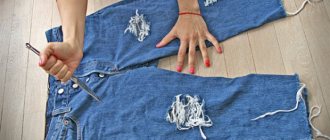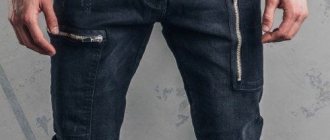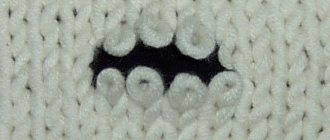Installing patches on jeans between the legs
There are several options for fixing holes. You can make the patch by hand or using a sewing machine. It can be either an invoice or a lining.
Repairing Holes with an Overlay Patch
- Cut off any loose threads from the hole.
- Use a buttonhole stitch to stitch the hole to give it a neat look.
- Choose the material of the desired color.
- Cut a flap of a certain shape, which should be larger than the size of the hole.
- Tuck the cuts in it by 1 cm.
- Baste the prepared patch from the front side.
- Sew on the patch using a sewing machine.
The hole can be treated with a patch, which is decorated with fringe on all sides.
Repairing holes with a backing patch
- Cut a patch of a certain shape, larger than the size of the hole.
- Baste it from the wrong side with the right side facing up.
- Select threads of a certain color and zigzag along the hole several times. The selected color of thread will make the patch on the jeans between the legs invisible.
You can also bend the cut edges of the hole to the wrong side. Sew from the right side of the folded edge of the product.
Read more: how to sew pants between your legs and prevent the formation of new holes.
A thing doesn't age within a season
In other words, from television screens the idea is persistently introduced into the consciousness of the broad masses of the population that after a couple of years after purchase, every thing becomes unfashionable.
However, if some wealthy socialite can agree with this, then a practical woman in the street is not at all obliged, under the pressure of such dubious arguments, to refuse clothes that are still suitable for use.
All that is needed to return it to decent form is to eliminate the rupture or persistent contamination with your own hands.
True, modern women are so absorbed in working at the computer in the office and then at home that they have completely forgotten all those simple sewing techniques that their mothers and grandmothers regularly used.
Repairing holes in jeans at the knees manually and using a machine
Today, scuffs or cuts in a product are not a problem; they are a trend in youth fashion. A beautifully designed hole in jeans can turn the product into a stylish and unusual addition to a modern look. To hide imperfections, you can use leather appliqué, ethnic style or factory-made thermal appliqué.
Master class: how to fix a hole in jeans using a leather patch
- Trim the excess threads and sew the hole edges using a buttonhole stitch by hand, overlock or zigzag.
- Prepare a leather patch of the chosen shape.
- Place it at any angle and sweep it.
- Sew with a machine artistic stitch along the edge of the patch or make a stitch.
In order for the applique to have an aesthetic appearance, its sections can be processed with zigzag scissors.
Video on the topic
Master class: how to fix a hole in jeans using ethnic style
- Give the hole a certain shape. Cut off any protruding threads or make a fringe along the edge.
- Choose a colored piece of cotton or linen fabric for a patch on the knee.
- Cut the fabric patch 1-1.5 cm larger than the hole.
- Baste from the wrong side so that the front side of the patch is visible through the cut.
- Sew the patch along the contour using a machine stitch or sew it on by hand.
- Around the outline of the patch, lay several rows of embroidered stitches with a Bulgarian cross, which looks like a snowflake.
Select the thread for the cross to match the color of the patch. For embroidery, it is better to use acrylic threads or floss.
Master class: how to repair a hole in jeans with factory-made iron-on appliqué
- Choose a sticker and interlining larger than the cut in the product.
- Flatten the cut. Glue the non-woven fabric on the inside with an iron so that the adhesive layer is on the front side of the product.
- Apply a sticker to the problem area.
- Baste with thread or pin it with tailor's pins.
- Apply a damp cloth to the thermo-application and iron on the patch.
- Iron the napkin until completely dry.
- Give the sticker time to cool.
- The product is ready!
You can use parchment paper instead of a wet wipe. To prevent the sticker from coming off and the product losing its aesthetic appearance, it is advisable to sew it along the edge to the jeans.
Japanese technique "Boro"
The technique originated in the Middle Ages in the Land of the Rising Sun. Boro art consists of numerous parallel stitches of equal length, hand-crafted. They resemble darning with coarse threads. For ease of use, needlewomen advise using long needles.
- To repair damage to jeans, choose thin denim, cotton or linen fabric.
- To work, choose a flap of any shape. The seam allowance should be 3-4 cm.
- Finish the outline of the cut or hole with forward stitches using a needle. In this case, the damage will not stretch further.
- Parallel to the outline of the hole, use a washable felt-tip pen to draw parallel lines for future embroidery. The distance between them can be 0.6-0.8 cm.
- From the wrong side, baste the prepared patch.
- Apply smooth stitches along the marked lines, which should be longer on the front side than on the back side.
- You need to turn the stitch onto the next row from the wrong side. Continue embroidering in the opposite direction.
- Make several rows of stitches on the bottom and top of the patch of different lengths, as well as on the sides.
The cuts on the flap can be slightly frayed if the flap is sewn on the front side of the product. To add style to the patch, you need to choose different stitch lengths and thread colors.
Video about Boro technique
Some useful tips
It is worth listening to the advice of experienced housewives:
- Be sure to turn the item inside out when you plan to sew it up. The front side of the item must be made perfectly, with invisible seams and knots.
- A seam ripper will be a great help when removing unnecessary stitches.
- Store needles correctly. They should be stuck into a pad or paper.
- Try to work on your own mistakes, because the first attempt may not always be successful.
- The thread should always be matched.
- Be sure to finish the work with the correct stitches, because if you leave the thread and do not fix it in any way at the end, the seam will simply fall apart.
If you are very worried and afraid to sew up the item yourself, then it is better to contact a tailor shop that will readily solve all problems with torn clothing.
https://tkanix.guru/rukodelie/kak-zastopat-dyrku-na-tkani-nezametnohttps://www.liveinternet.ru/users/trifonova_irina/post439127448/https://tden.ru/dom/kak-zashit- dyrku
Lace patches on jeans
Ripped jeans have been trending for a long time. Craftswomen are trying to transform them and make them more stylish. Lace is used for women's trousers. If the holes are on the hips of the product, buttocks or in places above or below the knees, then patches will make the jeans special.
Master class: masking a hole in the thigh with a patch
- Take measurements of the hole.
- Prepare a lace patch. Cut out a motif from it, which should be 3-4 cm larger than the cut.
- Give it a neat look. To do this, you need to process the sections manually using a buttonhole stitch or a zigzag stitch.
- Iron the hole with a damp cloth to even out all the cuts.
- Place a lace patch on top. Baste it or pin it with tailor's pins.
- Sew a patch along the edge of the hole.
Small floral designs can be cut out of the lace fabric and patches placed around the damage or down the side seam of the pant leg.
Master class: filling a hole in jeans with a lace patch
- Give the hole a certain shape. Rip all the edges in it. The fringe should not be more than 0.5-1.0 cm.
- Cut out the lace flap. Its size should be no less than 2-2.5 cm than the hole.
- From the wrong side, place the patch on the hole and baste.
- Turn the product inside out. Sew a lace patch along the edge of the hole on the front side.
- The product is ready!
Craftswomen do not recommend using lace patches to repair damage in the fold areas. They wear out quickly.
How to properly seal a rip in jeans with a machine tool?
Beginning craftswomen are interested in the question: how to sew a patch beautifully so that it is invisible. To do this, you need to decide on the patch that will be located on the wrong side of the product. This can be a factory patch with an adhesive base or a piece of thin fabric to match the jeans. For darning you need to use polyester thread No. 60.
Rip in jeans between legs
Selecting the adhesive for the patch
Glue the patch with an iron
We carry out the piece from the front side
View and back
Finished jeans after repair
Master class: invisible patch on jeans
- Select a textile patch of a certain size.
- Baste a fabric patch or glue a factory patch on the wrong side. Glue the adhesive-based patch using an iron and a damp cloth.
- From the front side, straighten the threads on the cut and iron.
- Adjust machine stitching. It should not be wide – 0.1-0.2 cm.
- Lay the lines perpendicular to the cut, extending beyond it by less than 0.7-1.2 cm. To do this, you need to use the forward and reverse function in the machine, which will form a zigzag. The distance between them should be 0.1-0.2 cm.
- Sew the entire cut with parallel stitches.
- Expand the work. Place parallel lines along the cut.
- The product is ready!
Seamstresses recommend using this method to seal holes between the legs on trouser legs. Correctly selected thread color will make the patch unnoticeable, without any discomfort.
No matter how you fill the holes, they will make the product trendy and decorate your wardrobe. You can combine several hole repair options in one product. To give the trousers a glamorous look, the patches can be decorated with rhinestones or beads.
How to darn with a hidden seam
A blind stitch will help to sew two elements of fabric so that the threads are not visible from the front side. If you follow sewing technology correctly, then your work will be indistinguishable from machine stitching. To get the correct blind stitch, follow these instructions:
- To begin, carefully iron the seam allowances of the garments you are sewing inside out.
- We make the first seam. The needle and thread must be inserted from the inside into one of the folds so that the knot remains hidden, and the working thread “comes out” exactly along the edge of the fold of this part.
- Next, grab a few millimeters (3-6) of fabric from the opposite side with the needle. The result should be a straight stitch connecting the two pieces. The needle then comes out again to the front side to make the next stitch.
- Again, pick up a few millimeters of fabric from the opposite side and bring the thread to the right side of the fabric. When completing the stitch, gently pull the thread. Be careful not to tighten the parts too much. You shouldn't be too zealous here.
- Continue working like this. Finally, make two knots to better secure the thread.
Tip : space the stitches evenly and make them the same, so the work will look neater and more beautiful.











